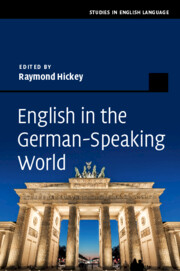Book contents
- English in the German-Speaking World
- Studies in English Language
- English in the German-Speaking World
- Copyright page
- Contents
- Figures
- Tables
- Contributors
- Preface
- Chapter 1 English in the German-Speaking World: The Nature and Scale of Language Influence
- I The Status of English
- II The Transmission of English
- III Domains and Features of English
- IV Beyond Germany
- Chapter 14 Varieties of English in the Netherlands and Germany
- Chapter 15 English in Austria: Policies and Practices
- Chapter 16 English in Switzerland
- Chapter 17 English and German in Namibia
- Chapter 18 English in German-Speaking Wisconsin and the Aftermath
- Chapter 19 The English ‘Infusion’ in Pennsylvania German
- Index
- References
Chapter 15 - English in Austria: Policies and Practices
from IV - Beyond Germany
Published online by Cambridge University Press: 11 November 2019
- English in the German-Speaking World
- Studies in English Language
- English in the German-Speaking World
- Copyright page
- Contents
- Figures
- Tables
- Contributors
- Preface
- Chapter 1 English in the German-Speaking World: The Nature and Scale of Language Influence
- I The Status of English
- II The Transmission of English
- III Domains and Features of English
- IV Beyond Germany
- Chapter 14 Varieties of English in the Netherlands and Germany
- Chapter 15 English in Austria: Policies and Practices
- Chapter 16 English in Switzerland
- Chapter 17 English and German in Namibia
- Chapter 18 English in German-Speaking Wisconsin and the Aftermath
- Chapter 19 The English ‘Infusion’ in Pennsylvania German
- Index
- References
Summary
As a ‘country of immigration’ (e.g. Marik-Lebeck 2009), Austria is best described as multilingual. Although not surprising in view of the country’s history and geographical location, this insight stands in clear contrast with a still widely held monolingual self-perception, which is also reflected in the Austrian Constitution (Art 8, Section 1): next to acknowledging the linguistic rights of a few long-standing minorities, German is identified as ‘Staatssprache der Republik’ (state language of the republic), granting no legal rights to the widely used immigrant languages. Investigating this imbalance of monolingual ideology and multilingual realities, recent sociolinguistic research has provided detailed information on the linguistic complexity of German, autochthonous, immigrant and foreign languages in contact and conflict, and on possible societal implications regarding language use and language learning (e.g. Busch and De Cillia 2003; ÖSZ 2009; De Cillia and Vetter 2013). At the same time and complementarily to such multilingual investigations, a careful sociolinguistic description and analysis of the language resources and scenario also requires special attention to individual languages. Fitting to this volume, our focus here is on English, which, while lacking any territorially based claims, is a relevant contender for a detailed language policy in any nation state, as pointed out by Spolsky (2004: 91). Given its unique status as main global and European lingua franca and as most widely learnt foreign language, it is the aim of this chapter to offer a sociolinguistic discussion of the roles, functions and use of English in Austria in the early twenty-first century.
- Type
- Chapter
- Information
- English in the German-Speaking World , pp. 294 - 314Publisher: Cambridge University PressPrint publication year: 2019

